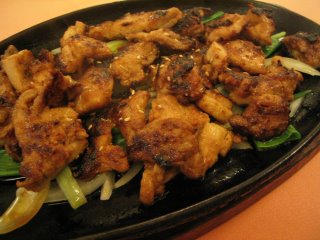Akined to Pumpkin
 [Spicy Thai Pumpkin Soup]
[Spicy Thai Pumpkin Soup]If you've read my previous post about the wonders of pumpkin's orangy flesh, you know I'm completely infatuated with this big fat squash that conjures up tales of a certain golden pumpkin coach. I normally buy my pumpkins, freshly and generously sliced on the spot, from my favorite green-grocer in Barcelona, Bubub.
Entering the tiny store takes you into a rustic setting with big straw baskets on the floors filled to the brim with farm-fresh vegetables, and wooden shelves on the walls displaying organically grown greens from its own nearby farm outside Barcelona. It's a wonder that smack right in the middle of the most culturally colorful neighborhood and just one tiny block away from the sanitizedly white walls of the Museum of Modern Art (MACBA), you can find such a quaint little vegetable store. The two ladies that shared the two shifts are extremely friendly and helpful too. Once one of them patiently pointed out to me the difference between chiviria (parsnip) and nabo (turnip).
The other day I came across a curious receipe of a Thai pumpkin soup infused with southeast asian spices and ingredients like dried shrimp, lemongrass and coconut milk. I wondered what it would taste like, so I ran a search on google and observed the array of recipes. The end result came out rightfully Thai in taste, and deservingly worth a little mention on this food blog. If you can find a handful of dried shrimp from your local asian grocery store, you should be able to recreate the exotic taste of this spicy Thai dish (it is not too exotic for me though, in fact I find it homey.)
P.S. Bubub-Verdures i Hortalisses is situated at C/Joaquim Costa 29 in the Raval. Nearest metro is
Spicy Thai Pumpkin Soup
Ingredients:
1 tablespoon vegetable oil
1 tablespoon butter
1 clove garlic, minced
4 shallots, finely chopped (can be substituted with one small onion)
4 cups fresh pumpkin, peeled and scliced into 1/4-inch thick squares.
1/4 cup dried shrimps -- soaked for 5 minutes in warm water, drained and finely chopped.
1 small fresh red chili pepper, seeded and thinly sliced.
1 stalk of lemon grass (optional) use only the bulb or the white part, finely sliced.
1 1/2 cups unsweetened coconut milk (canned or powdered)
1 cup vegetable stock
1 cup water (add less or more according to your preferred consistency.)
salt and pepper to taste
Elaboration:
Heat a nonstick saucepan over medium-high fire. When it is hot, add oil and butter and heat up for half a minute. Feel your hands above saucepan. When you feel heat arises from the oils, throw in shallots (or onions) and stir-fry until golden brown. Then add garlic, dried shrimps, lemongrass and chili pepper and stir-fry til its aromas are released (I add each item in this order one at a time at an interval of 30 seconds and stir-fry all for about 1 minute). Work delftly with a wooden spatula and be careful not to burn garlic.
Now add sliced pumpkin and stir-fry on medium-high fire for about 2 minutes until significantly softened. When you can break a piece of pumpkin easily with the spatula, stir in vege stock, coconut milk and water gradually and bring contents to a boil. Cover saucepan and turn fire down to the weakest possible simmer for 10 minutes.
Now if you have an immerge-style or hand-held blender, plunge the apparatus into the saucepan and blend the soup till you get a smooth or slightly chunky consistency, according to your likes. If not, pour contents into your counter-stand blender in batches and work the machine. Salt and pepper soup till you get the right taste.
To serve, ladle into bowls and squeeze in some lemon juice. If you've cilantro, basil leaves, or even fresh mint, you can do some pretty garnishing. I simply did mine with a dash of freshly ground black pepper and some chilli powder.

This is an entry for Kalyn's Weekend Herb Blogging.





















